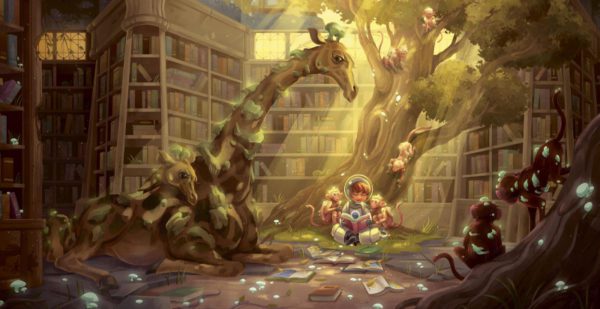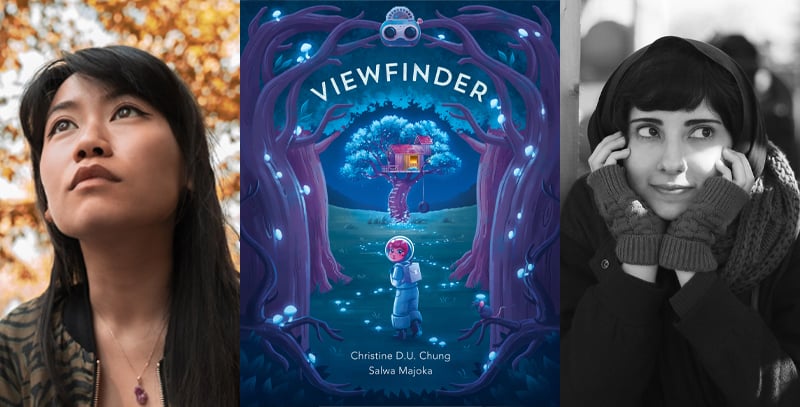This month, best friends and Adobe Creativity Scholarship alumni recipients Christine (Diễm Uyên) Chung and Salwa Majoka released their debut, Viewfinder. The wordless graphic novel, which was years in the making, tells the tale of a young astronaut in search of home.
Chung and Majoka spoke to Q&Q about the inspiration behind Viewfinder, what it was like working together, and what they hope readers take away from the book.
What inspired Viewfinder?
SM & CC: We had just finished working on a challenging animated-short project in high school and were ready to take on a completely different collaborative project in our early years of post-secondary. We really wanted to make a book because it was an entirely different medium than animation, and our goal was to make it very detailed, painterly, and full-colour from cover to cover. We were inspired by a lot of the interesting imagery we had been seeing on social media at the time of abandoned places being reclaimed by nature. … The cracks and overgrown foliage were very inviting in some ways, despite feeling lonely and eerie in others. We aimed to create a story that would facilitate a world where we could capture and explore those feelings while touching on themes of what a home is and how we value a place.
Why a wordless graphic novel?
SM & CC: Before we knew what Viewfinder was even going to be about, we knew we wanted the book to be wordless! We had been big fans of Shaun Tan’s The Arrival when we were in school; we were so enamoured by the impeccable visuals that told such a thoughtful story without words. Wordless graphic novels are unique in the opportunity they provide readers to interpret and form their own ideas based on the images they see. We hoped to create a book where audiences could build upon their ideas with each rereading.
Christine, you handled the drawing, and Salwa, you were responsible for the painting. Did these roles come naturally?
SM: Christine and I had worked on an animated short together in high school, and we had actually occupied similar roles for that project as well (Christine on the under-drawings and myself creating the final painted versions of each animated frame). I think we naturally fell into the same roles on this collaborative project, too, because it worked well for us the first time around. Funnily enough, we took full-time jobs in animation after graduating that reflected these roles – I did background painting and Christine did storyboarding.
CC: I think we stuck with what interested us the most. In a book like ours, the locations are like another character themselves, and I was so excited to draw and design these expansive scenes! There were some very challenging spreads, but in that sense, I’m grateful that Viewfinder gave me the opportunity to push my skills.
Was there a lot of experimentation to arrive at the lush colour palette?
SM: I’ve always naturally gravitated towards using a lot of bright colours in my work. It’s been that way ever since I first started playing around with digital art when I was 12; I was fascinated by the ability to use such rich and saturated colours on the screen without limitations. For Viewfinder, I went with my intuition for what colours “felt” right for particular parts of the story based on things like the location, lighting, weather, time of day, and, of course, the mood and emotions we were trying to communicate. I usually had a particular vision for most scenes, so I wouldn’t say there was too much experimentation, but I would show Christine a colour rough for the main spreads (that would also inform the colours of the surrounding spreads), and if she felt differently, I would go back and try additional colour passes. The goal was for each location to have a distinct palette so that the colours would inform the various emotional arcs and story moments.

What was it like working with your best friend?
CC: For the most part, Salwa and I have had similar sensibilities when it comes to art. Also, we’re both very curious and wonder-driven people. Prior to working on Viewfinder, we had worked on projects together and it always felt very natural. One of our art teachers said that seeing us work together was like “seeing many hands weave together.” I think what’s great about how Salwa and I work is that we are always considering each other’s opinions and are trying to find solutions where both parties can feel satisfied. We’re very solution-focused. I think that’s how we’ve been able to work with each other and still maintain our friendship.
Can you speak about being Adobe Creativity Scholarship alumni recipients?
SM: The Adobe Creativity Scholarship was a big blessing for me, not only financially, but also as encouragement to follow my passion. As someone from a South Asian background who immigrated to Canada as a baby, pursuing a creative field was far from a consideration for a long time. I didn’t know anyone from my background who had done it before. When I was awarded the scholarship (from among applicants worldwide), it not only validated the hard work I had been putting in until then, but it basically gave me the “okay” to study what I enjoyed. It also helped ease my family’s uncertainties in some ways, and being free of the financial pressures allowed me to foster other goals and ambitions while I was still in school. Like, for instance, trying to publish a book!
CC: Salwa and I had worked with the Adobe Youth Voices program when we were in high school and made several animated projects with them during our time there. I’m very grateful for the momentum they provided. I never imagined there would be organizations that would invest so generously in me and my artistic endeavours. I recognize it’s a huge privilege. I don’t think I would have been able to put as much time and energy into becomings a storyboard artist – and into Viewfinder – if I had had to worry about paying off my student debt.
What do you hope readers take away from Viewfinder?
SM: In our story, the astronaut is able to observe and learn about our world with a sense of wonder and curiosity because she’s exploring it for the first time. I hope that through her viewpoint, readers can rekindle a similar sense of curiosity and wonder for the truly fascinating places, creatures, and even people that occupy our world. It’s easy for us to take for granted all the things we see on a day-to-day basis or that we’ve grown up just knowing, but there is so much beauty and profoundness in even the smallest things. I hope readers are able to uncover a renewed sense of appreciation for all our planet has to offer.
CC: I hope Viewfinder’s readers, young and old, are reacquainted with their own sense of curiosity and feel an agency to explore, especially things that may not seem worthy of a second thought. Viewfinder is centred on a world that has experienced a variety of changes, and our little astronaut is the witness. It’s very easy to relate it to the very scary changes that we are experiencing with planet Earth now. Transformation is change; nothing truly stays the same. There are opportunities for positive turns to be taken, even among the difficulties. That offers an avenue for optimism, and I hope readers can feel that too.
This interview has been edited and condensed.
l to r: Christine (Diễm Uyên) Chung (Credit: Theo Do Forro (Åwtter)) and Salwa Majoka (Credit: Shanuja Nagarathinam)

 Contact us via email
Contact us via email

